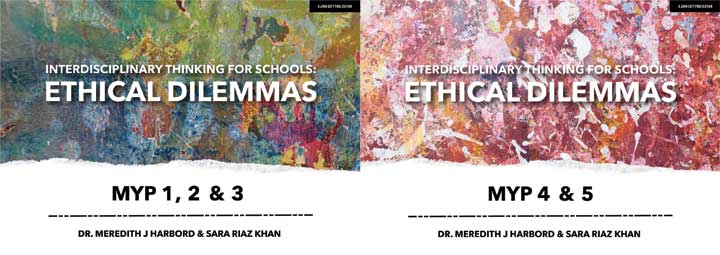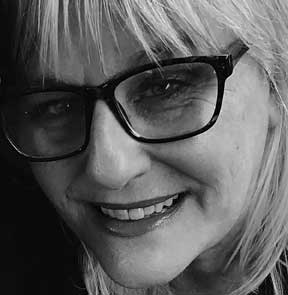Kamakshi Balasubramanian
Interdisciplinary Thinking for Schools: Ethical Dilemmas MYP 1, 2 & 3 vol 1
Interdisciplinary Thinking for Schools: Ethical Dilemmas MYP 4 & 5 vol 2
Publisher John Catt Educational Ltd

Life-long learning means, in addition to acquiring skills and knowledge, refining our ethical positions and integrating them into our behaviour as social beings. Teaching ethics begins early in all cultures, for example, through storytelling and inculcating socially acceptable behaviour. What role does formal education play in developing ethical awareness in school children?
Two educators have taken on the task of writing a textbook in two volumes to address this question with a practical approach. Meredith Harbord and Sara Khan taught design at ABA – an IB World School in Muscat, Oman, and from this teaching collaboration, the idea for writing this book evolved. Over the past few years, they have presented at international conferences, written articles and run workshops for students and teachers. Together they have formed HK Educational Consultants and are available to collaborate with schools either online or in person.
As design specialists, the authors have approached discussion of ethical problems through a unique innovative ethical designs project. These designs are illustrated with rich artwork that is sure to inspire purposeful learning, requiring learners to connect skills and concepts learned in different subject areas. Their book is meant for children in the Middle Years Program (MYP) of the International Baccalureate Organization’s curriculum. All the units are interdisciplinary in nature and call upon the learner’s creativity and teamwork to examine critical issues in our present-day world with its many problems that require sustainable, just and ethically sound solutions.

In the following interview, the authors, Meredith Harbord and Sara Khan (jointly) describe the scope of their book, why teaching ethics at the middle school level is important and how their book, which uses design projects as the vehicle for this purpose, could be adapted to national curricula.
Question 1. How important is it to introduce ethics as an area of inquiry in the MYP?
It is essential to introduce young people to ethics in every curriculum area and interdisciplinary learning is one way of doing this. Both designers and educators carry a tremendous responsibility and have valuable opportunities to promote ethical ideas about topics such as sustainability, social justice, and ecological awareness. The Middle Years Programme (MYP) of the International Baccalaureate promotes ethical values together with its IB Learner Profiles https://www.ibo.org/contentassets/fd82f70643ef4086b7d3f292cc214962/learner-profile-en.pdf.
In our classroom, we focused on teaching how design can have a positive impact on the self (learner), the community and real world issues: for example, students created models for a ‘Design for Disaster’ unit, creating emergency shelters for a context of their choice.
Practical examples:
How to embed differentiation into your classroom with ease.
If we use the unit ‘Design for Disaster,” students can choose different modalities to solve the problem. For example, budding architects could design an economical structure to provide shelter and protection for families whose homes have been destroyed. Students interested in engineering might design systems to deliver fresh water or power. Perhaps a student is interested in a medical career and emergency packs or materials might be necessary for medical teams. The problem will be solved in many different ways but relies on knowledge from many school subjects to generate a solution.
A teacher could take an ethical dilemma such as in Chapter 2, Honor. “The Olympic ideals and sports diplomacy promote positive values through sports. Are these compromised by unethical practices that sometimes arise?” Students can justify their point of view about continuing to hold the Olympic Games or discontinue them on the basis of scandals which sometimes arise.
The idea is to challenge the students to design an elevator pitch to support their viewpoint. They can use persuasive speaking strategies and demonstrate how language is used to influence people. The history of an elevator pitch is that in advertising, often a junior in a company would meet a manager in an elevator and only have 30 seconds before the manager would leave, so they honed their speech to capture the essence of the idea and sell it to their boss. An elevator pitch must have fluency, persuasion and be no more than 30 seconds long. This is a fun activity to try with students, as to be successful they must synthesize their knowledge.
Question 2. Design isn’t the most obvious learning activity one normally thinks of when one introduces concepts in ethics to school children. How did you come up with this idea for a book?
Design is an inherent part of our lives and can impact our value systems and behaviour positively or negatively, e.g., the ways spaces are designed can influence how we behave within them, advertising can shape the choices parents make for their children. At this time, young people are at the forefront of the call for responsible, environmental action.
Students can follow their interests and learn from failure, while working with an ethical intention. Design projects include student collaboration which is a vital part of student learning in the 21st century.
We noticed that many teachers struggled with how to embed ethical viewpoints into the learning experience so that students would engage and have empathy towards our global world. It can be challenging for a classroom teacher juggling planning lessons and writing unit planners. By collaborating on this book and drawing on our own experience of teaching design, we wanted to make it easier for other teachers to provide students with an ethical understanding. Now that all IB schools need to be teaching interdisciplinary units of work, we hope our book can support teachers, curriculum leaders and MYP coordinators.
Question 3. How much design work do children do in their MYP?
Design has a wide appeal and is a compulsory and important subject for students in their MYP curriculum. It frequently addresses requirements in technology and offers diverse, creative opportunities. There are many choices within the subject, for example, computer generated design, robotics, illustration, animation, game design, graphic design, architectural modeling, and product design to describe a few areas.
A practical example
Innovation and critical thinking
Through using the design thinking model, students can explore a problem and navigate their way to create new and novel solutions. Often, in their cumulative Personal Project in Grade 10, students can apply their knowledge and skills from design, such as design specifications to brainstorm and evaluate ideas.
Question 4. Which thinkers, scientists, artists, humanitarian workers, educators do you consider your inspiration? Could each of you name one person and briefly talk about how you were inspired?
We were very fortunate to be given interviews with inspiring students, leaders, thinkers, and creatives. All these experts were passionate about contributing to a greater cause and value education highly. These include the astrophysicist Martin Rees, Dr. Jane Goodall, primatologist and anthropologist, Alberto Alessi, Abeer Seikaly architect, NASA astronaut Paul Lockhart, analog astronaut Kartik Kumar. We have also been inspired by individuals who have taken action to redress wrongs they see in society; Sam Farmer felt that products for his daughter and other girls were being marketed in a way which was damaging for their self-esteem, and developed a range of gender neutral products for young people. Other inspiring role models include Donna Strickland, who together with Gérard Mourou, won the Nobel Prize for Physics in 2018.
Question 5. Have you considered how your work would assist teachers in national curricula?
In our book, we demonstrate how teachers and students can write their own ethical dilemmas to address local, relevant issues through an interdisciplinary lens and adapt these ideas to their specific situation. Part of the strength of the books is that teachers can select from the various options and use what will support their particular students’ learning needs. The IB frameworks are frequently used in conjunction with national curricula in many different countries, so one has the flexibility to use the sections of the content and summative tasks that meet their needs.

Question 6. In teaching ethics, how are learning outcomes measured or assessed?
As ethical dilemmas are included into the content, students work through activities that draw their attention to ethical issues and they are given opportunities to discuss and debate these; therefore the assessment is embedded into the summative tasks. Student tasks are aligned to their development levels so there are possibilities for both “vertical and horizontal alignment.”
Question 7. In your book, do you discuss how learners share personal reflections?
We have outlined different strategies for reflection, personal, peer reflections, blogs, audio, class discussions, reflections for both formative and summative tasks. As we use both the Inquiry Cycle and the Design Cycle, analysis, evaluation, and reflection are required at every stage.
What your teachers might be interested in is the exemplar samples of students’ work. A school from New Delhi, contributed a science project for grade 7 students. This was based on the study of trees and the student reflections from this project were fascinating.
“We started the Partner Tree project, in which we were assigned to a tree on campus. I was assigned to the Thor, or Euphorbianeriifolia tree and spent time researching and studying it. Our research included, finding the origin of the species, its uses by man, its uses by other animals. I think this helped us appreciate the flora around us.” (Grade 7 student)
Question 8. Why did you use “ethical dilemmas” in your book title? Why not something simpler – say, “Issues in Ethics” or “Ethical Conduct”?
We wanted to engage students with the content on an emotional level, without being prescriptive or addressing the history of ethics. At some level or the other we all face different moral dilemmas in everyday life so students can relate to this idea. Investigating an ethical dilemma allows students to consider the complexities of the issue and think about both sides.
Question 9. What inspired you to set out to write a book in two volumes?
Initially we had intended it to be one book but as our approach is multi-layered, our content grew and we felt one book would be unwieldy to use and difficult to distribute. After discussions we decided it would be useful to separate the book into MYP 1, 2&3 (grades 6-8) and MYP 4&5 (grades 9&10) as frequently teachers taught in one school section only.
BIOS
Meredith Harbord Ed.D, is an international educator who has worked in education for over 30 years with a particular interest in curriculum. She is an adjunct professor for State University of New York at Buffalo (International Graduate Program for Educators) as well as a consultant for Core 21 Education Services US. Meredith was originally a secondary art and craft teacher from Melbourne before travelling overseas to teach in Brunei, Darussalam, UK, and the Sultanate of Oman. The International Baccalaureate education system furthered her interest in middle years design. Meredith’s doctoral dissertation focused on MYP design and through this work an interest developed to embed ethical dilemmas into design curriculum. Her educational philosophy advocates that learning experiences should be fun.
Sara Riaz Khan is an educator and artist; while teaching MYP design, she was inspired by the idea of ‘responsible’ design and its impact on student learning. She established an MYP student group, raising whole school awareness about the environment. Sara’s engagement with creative ways of thinking developed her interest in making connections between curriculum and real world issues. As an arts educator, Sara has taught MYP art, been an artist-in-residence, and held student workshops supporting diversity. Most recently, Sara was a panelist at a London Design Festival Event (‘People and Planet over Profit’) in 2019. A practicing visual artist, Sara has exhibited internationally since 2004, focusing on nature, transformation, and a common humanity. Her background in this field includes research, gallery work, administrative support, and exhibition tours.
The author is an educator and occasional writer with significant experience in teaching at secondary and tertiary levels. She can be reached at
